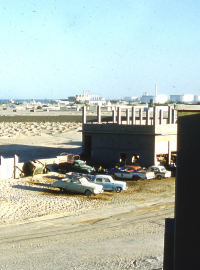Carbon Dioxide Discovered
The Flemish chemist Jan Baptist van Helmont observed that when he burned charcoal in a closed vessel, the mass of the resulting ash was much less than that of the original charcoal. His interpretation was that the rest of the charcoal had been transmuted into an invisible substance he termed a "gas" or "wild spirit" (spiritus sylvestris).

First Carbon Dioxide Detector
Joseph Black, a Scottish physicist and chemist, observed that "fixed air" (what he called CO2) was denser than air and did not support flame or animal life.
Black also found that when an aqueous solution of lime (calcium hydroxide) was bubbled through, calcium carbonate was deposited. He used this phenomenon to illustrate that carbon dioxide was produced by animal respiration and microbial fermentation.
Learn more: The Discovery of the Greenhouse Effect

Industrial Revolution Begins
Since the beginning of the Industrial Revolution, the way people live and work has changed dramatically as manufacturing expanded. Over time, more and more fossil fuels were burned, increasing the amount of carbon dioxide (CO2) in the atmosphere. Before the Industrial Revolution, the level of CO2 in the air was about 280 parts per million (ppm). Today, that level is over 400 ppm.

Describing Earth's Atmosphere as a Greenhouse
Jean-Baptiste-Joseph Fourier, a mathematician who worked for Napoleon, was the first to describe how the Earth's atmosphere retains heat on an otherwise very cold planet. To explain this concept, he compared the atmosphere to the glass walls of a greenhouse.
Learn more: The Discovery of the Greenhouse Effect

Discovering Gases that Trap Heat
Eunice Foote, an American scientist, discovered that carbon dioxide and water vapour cause the air to heat in sunlight. In 1856, she presented her findings at the American Association for the Advancement of Science (AAAS) meeting.

Testing the Heat-Trapping Ability of Gases
John Tyndall, a British physicist, tested the gases in the atmosphere to find out which were responsible for the greenhouse effect. He found that nitrogen and oxygen, which make up almost all of the atmosphere, cannot trap heat, but three gases that are present in smaller amounts can: Carbon dioxide, ozone, and water vapour. Tyndall speculated that a decrease in these gases would lead to a cooling of the Earth.

Evaporating Coal into the Air
Svante Arrhenius, a Swedish chemist, wrote in a scientific article that "we are vaporising our coal mines into the air." He added that this would eventually have effects on the atmosphere that could lead to a warming of the planet.

Increasing Carbon Dioxide and Increasing Temperatures
The British coal engineer Guy Stewart Callendar compiled all the carbon dioxide measurements for the last 100 years and found that the amount of CO2 was increasing. He also found that temperatures were rising. His conclusion was that this was a good thing, that "the return of the deadly glaciers should be delayed indefinitely."
Read the 1949 article: Can Carbon Dioxide Influence Climate?

Shrinking Arctic Sea Ice
Measurements since the 1950s show that the amount of sea ice in the Arctic is decreasing. The Arctic is expected to have no summer ice cover by the middle of this century.
Check on sea ice at the National Snow and Ice Data Center

Air Pollution Dampens Warming
Aerosols emitted into the atmosphere from smokestacks and tailpipes caused the climate to cool slightly, fuelling speculation that we might be entering an Ice Age. As countries passed clean air laws, aerosol pollution declined and global warming continued.

Our Unintended Experiment
Roger Revelle, U.S. oceanographer, and Hans Suess, Austrian-born U.S. chemist, recognising that carbon dioxide from industrial sources must be accumulating in the atmosphere, wrote in 1957: “Thus human beings are now carrying out a large scale geophysical experiment of a kind that could not have happened in the past nor be reproduced in the future.”

Climate Science on Television
The Bell Telephone Science Hour addressed how our actions could change the Earth's climate. “Even now, [we] may be unwittingly changing the world's climate through the waste products of [our] civilisation,” the speaker said. “Due to our release from factories and automobiles every year of more than six billion tons of carbon dioxide, which helps the air absorb heat from the Sun, our atmosphere seems to be getting warmer.”

Daily Measurements of Carbon Dioxide
Charles Keeling began taking daily measurements of the amount of carbon dioxide in the air at Mauna Loa in Hawaii. On that first day of March, he found 313 parts per million (ppm) of carbon dioxide in the air. Measurements, still being taken every day, reached 400 ppm on May 9, 2013, and continue to increase.

Climate in Congress
NASA Climate scientist James Hansen testified before the Senate Energy and Natural Resources Committee that the climate is warming, that greenhouse gases are responsible for the warming, and that we are responsible for the increase in these gases.

An Increasingly Acidic Ocean
U.S. scientists Stephen V. Smith and R. W. Buddemeier pointed out that more carbon dioxide (CO2) in the ocean could be a problem for coral reefs. Later experiments confirmed their hypothesis that CO2 makes seawater slightly acidic, making it difficult for corals and other animals to build reefs. Today, the scientist Joanie Kleypas at NCAR is building on their work, researching the effects of the acidic ocean on marine life.

Heat Wave Linked to Climate Change
Researchers found that climate change played a major role in the 2003 heatwave in Europe that killed more than 30,000 people.

Economic Impacts of Climate Change
The Stern Review described the economic impacts of climate change and concluded that mitigation measures (reducing greenhouse gas emissions) and adaptation measures (lifestyle changes) would be far more cost-effective than trying to recover from the catastrophic effects of climate change in the future.
Read the report: The Stern Review on the Economics of Climate Change

Studying Impacts in the Polar Regions
During the International Polar Year, which actually lasted two years (2007-2008), scientists documented numerous impacts of climate change on polar regions, which are warming faster than other areas of the world. The effects included melting ice, thawing permafrost, and changes in ecosystems. They found that the changes were particularly pronounced in the Arctic.

The Effect of Climate Change on Extreme Weather
A new branch of climate science, called attribution research, has formed to study how global climate change affects extreme weather events such as heatwaves, hurricanes, floods and droughts. Every year since 2011, the Bulletin of the American Meteorological Society has published a special report on extreme weather events in the past year and how the risk of severe weather has changed due to climate change.
Read the report: Explaining Extreme Events from a Climate Perspective

CO2 Stays Above 400 PPM Year-Round
September is typically when carbon dioxide reaches a minimum in its annual cycle. September 2016 was the first time the minimum exceeded 400 parts per million. Before the large-scale burning of fossil fuels, CO2 levels were around 280 parts per million.
Learn more: The World Passes 400 PPM Threshold. Permanently

Dwindling Biodiversity
Using Earth system models, scientists can now study how species and ecosystems around the world might be affected by climate change and other human impacts. According to a 2019 report from United Nations, climate change and other human impacts such as pollution and land use threaten species worldwide. "Around 1 million species already face extinction, many within decades, unless action is taken," the report said.

